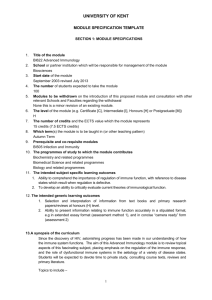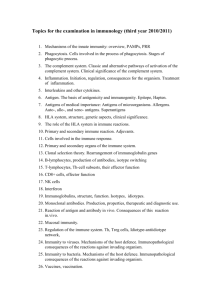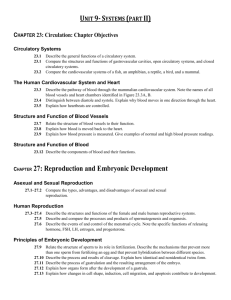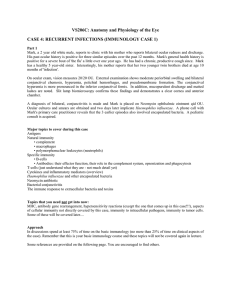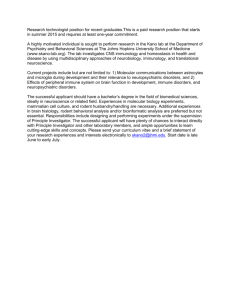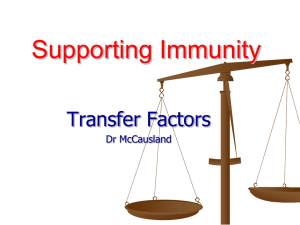General_Medicine_-_Oral_exam_questions_2014_
advertisement
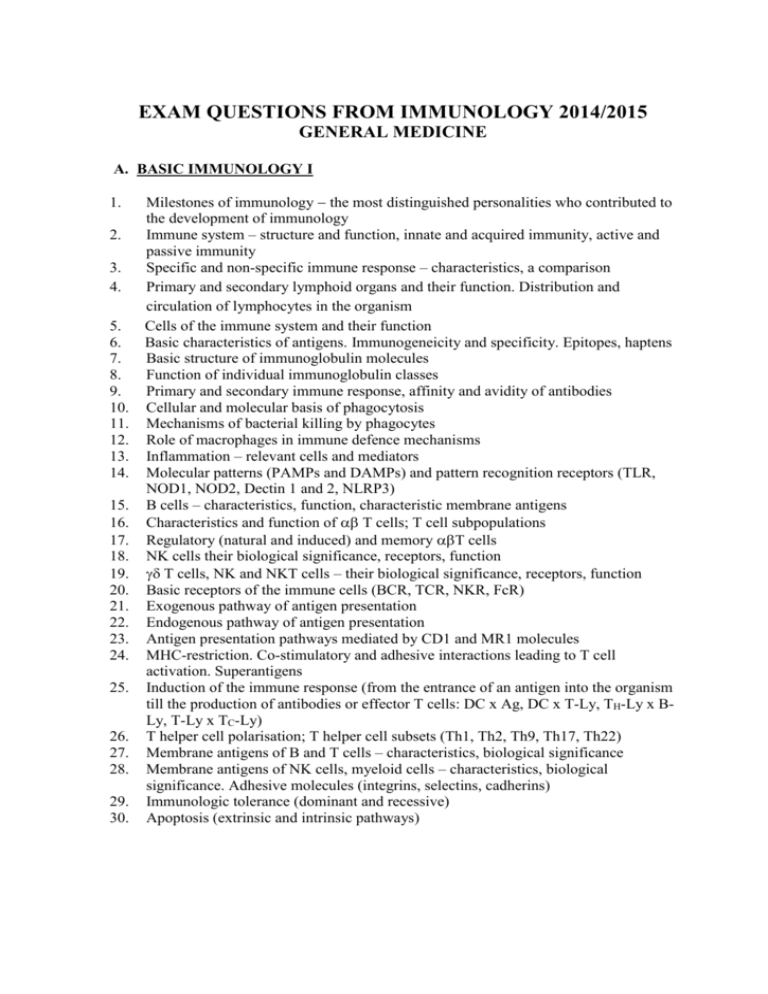
EXAM QUESTIONS FROM IMMUNOLOGY 2014/2015 GENERAL MEDICINE A. BASIC IMMUNOLOGY I 1. 2. 3. 4. 5. 6. 7. 8. 9. 10. 11. 12. 13. 14. 15. 16. 17. 18. 19. 20. 21. 22. 23. 24. 25. 26. 27. 28. 29. 30. Milestones of immunology the most distinguished personalities who contributed to the development of immunology Immune system – structure and function, innate and acquired immunity, active and passive immunity Specific and non-specific immune response – characteristics, a comparison Primary and secondary lymphoid organs and their function. Distribution and circulation of lymphocytes in the organism Cells of the immune system and their function Basic characteristics of antigens. Immunogeneicity and specificity. Epitopes, haptens Basic structure of immunoglobulin molecules Function of individual immunoglobulin classes Primary and secondary immune response, affinity and avidity of antibodies Cellular and molecular basis of phagocytosis Mechanisms of bacterial killing by phagocytes Role of macrophages in immune defence mechanisms Inflammation – relevant cells and mediators Molecular patterns (PAMPs and DAMPs) and pattern recognition receptors (TLR, NOD1, NOD2, Dectin 1 and 2, NLRP3) B cells – characteristics, function, characteristic membrane antigens Characteristics and function of T cells; T cell subpopulations Regulatory (natural and induced) and memory T cells NK cells their biological significance, receptors, function T cells, NK and NKT cells – their biological significance, receptors, function Basic receptors of the immune cells (BCR, TCR, NKR, FcR) Exogenous pathway of antigen presentation Endogenous pathway of antigen presentation Antigen presentation pathways mediated by CD1 and MR1 molecules MHC-restriction. Co-stimulatory and adhesive interactions leading to T cell activation. Superantigens Induction of the immune response (from the entrance of an antigen into the organism till the production of antibodies or effector T cells: DC x Ag, DC x T-Ly, TH-Ly x BLy, T-Ly x TC-Ly) T helper cell polarisation; T helper cell subsets (Th1, Th2, Th9, Th17, Th22) Membrane antigens of B and T cells – characteristics, biological significance Membrane antigens of NK cells, myeloid cells – characteristics, biological significance. Adhesive molecules (integrins, selectins, cadherins) Immunologic tolerance (dominant and recessive) Apoptosis (extrinsic and intrinsic pathways) B. BASIC IMMUNOLOGY II 1. 2. 3. 4. 5. 6. 7. Classical and lectin pathways of complement activation Alternative pathway of complement activation Regulatory proteins and receptors of the complement system Biological significance of the complement system Acute phase proteins – function, significance Cytokines general properties Cytokines mediating and regulating innate immunity (IL-1, IL-6, IL-12, IL-15, TNF) 8. Cytokines mediating and regulating adaptive immunity (IL-2, IL-4, IL-5, IL-10, IL17, TGF-) 9. Cytokines stimulating haematopoesis (CSFs, c-kit, IL-3, IL-7, IL-9, IL-11) 10. Chemokines. Interferons (class I, II, III) and their biological activities 11. Myeloid, plasmacytoid and follicular dendritic cells and their role in immunity 12. HLA complex – class I, II and III loci, genes. Inheritance of HLA-genes 13. HLA complex – biochemical structure and distribution of class I and II molecules 14. Biological significance of the HLA-complex and its role in clinical praxis 15. Mucous immune system (MALT, GALT, BALT, IgA, sIgA, poly-IgR, IgD) 16. Immune response developing in the lymph nodes and spleen a comparison 17. ABO and Rhesus blood groups (biochemical structure, genetics, Bombay phenomenon, development of isoantibodies) 18. Rhesus blood groups. RhD-incompatibility between mother and her child 19. Foeto-maternal relationship. Immune system of the fetus, newborn and infant 20. An overview of classical serological techniques and their principles (agglutination, precipitation, immunodiffusion) 21. An overview of modern serological techniques and their principles (ELISA, RIA, turbidimetry, nephelometry) 22. An overview of techniques used to evaluate the immune status of an individual 23. An overview of methods used to determine the function of natural immunity 24. An overview of methods used to determine the function of cellular immunity 25. An overview of techniques used to determine donor-recipient compatibility for organ and tissue transplants 26. Current possibilities of immunologic diagnostics of allergies in vitro and in vivo 27. Laboratory diagnostics of the HIV-infection C. IMMUNOPATHOGENIC MECHANISMS AND CLINICAL IMMUNOLOGY 1. 2. 3. 4. 5. 6. 7. 8. 9. 10. 11. 12. 13. 14. 15. 16. 17. 18. 19. 20. 21. 22. 23. 24. 25. 26. 27. Type I hypersensitivity reactions IgE and non-IgE mediated anaphylactic shocks Role of eosinophils, basophils, and mast cells in the development of allergic rhinitis, asthma bronchiale a atopic dermatitis Type II and V hypersensitivity reactions Type III hypersensitivity reactions local and systemic Type IV hypersensitivity (Delayed type of hypersensitivity) Transplantation nomenclature. Mechanisms of allograft rejection (HvG, GvH) General principles of donor recipient selection for organ and tissue transplantations Immunopathologic mechanisms leading to autoimmunity, antigens inducing autoimmune processes, main autoimmune disorders Genetic basis of autoimmunity (AIRE, FOXP3, HLA, Fas/FasL, complement genes), a role of hormones in autoimmune processes Factors inducing malignant processes (physical, chemical, biological; oncogenes). Effector mechanism of tumour defence Mechanisms of tumour cell escape from immune system surveillance. Immunology of metastatic process Immunodiagnostics and immunotherapy of tumours Immunostimulation (chemical a biological immunostimulatory agents/drugs) Cytokines used in the therapy of autoimmune disorders, tumours and immunodeficiences Immunosuppression, most important immunosuppressive drugs Conventional and monoclonal antibodies. Hybridoms. Monoclonal antibodies in the therapy of autoimmune diseases and malignancies Active and passive immunisation. Types of vaccines. Adjuvants Immunodeficiencies general features, classification Primary phagocytic immunodeficiencies (CGD, LAD1) and complement defficiencies (hereditary angioedema, paroxysmal nocturnal haemoglobinuria, C2 and C4 deficiency, terminal complement components deficiencies) Humoral immunodeficiencies (CVID, selective IgA-deficiency, hyper IgM syndrome, X-linked agammaglobulinemia) T cell immunodeficiencies (Di George and Nezelof syndromes, chronic mucocutaneous candidiasis) and combined immunodeficiencies (SCID, WiskottAldrich syndrome, bare lymphocyte syndrome) Structure of HIV virus; interaction of HIV with target cells and involved molecules The impact of HIV infection on the immune system Immunodiagnostic and therapeutic possibilities of HIV infection. Prevention of AIDS Immunity to extracellular and intracellular parasitic bacteria Immunity to viruses, fungi and parasites Prof. Milan BUC, MD, DSc. Head of the department
